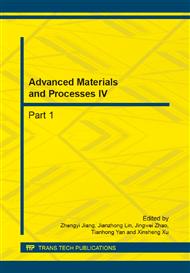p.94
p.98
p.103
p.108
p.116
p.120
p.125
p.129
p.133
Experiment on Direct Smelting and Alloying Process between High-Carbon Ferrochrome and Molybdenum Oxide
Abstract:
Based on the direct reduction alloying theory, experiments on chromium molybdenum alloy prepared through the direct reduction and alloying reactions between the high-carbon ferrochrome and molybdenum oxide were conducted in a laboratory scale. The critical factors that would impact the reduction rate of molybdenum oxide and the yield rate of molybdenum were analyzed. The results indicate that the reduction rate of molybdenum oxide can exceed 90%, meanwhile, the yield rate of molybdenum is affected by many factors and fluctuates in a wide range. As temperature rising, the reduction rate of molybdenum oxide is increased whereas the yield rate of molybdenum is decreased. With the amount of molybdenum oxide added increasing, the reduction rate of molybdenum oxide and yield rate of molybdenum are decreased simultaneously. Making slag during melting process and molybdenum oxide roasted by addition of lime are effective measures to improve the yield rate of molybdenum.
Info:
Periodical:
Pages:
116-119
Citation:
Online since:
September 2014
Authors:
Price:
Сopyright:
© 2014 Trans Tech Publications Ltd. All Rights Reserved
Share:
Citation:


